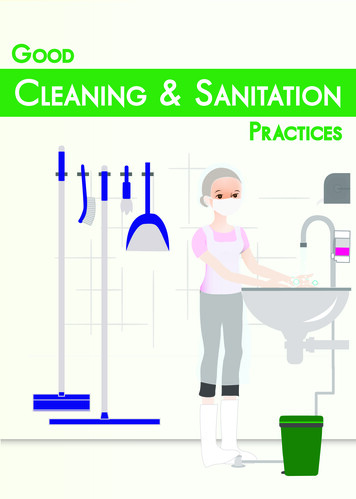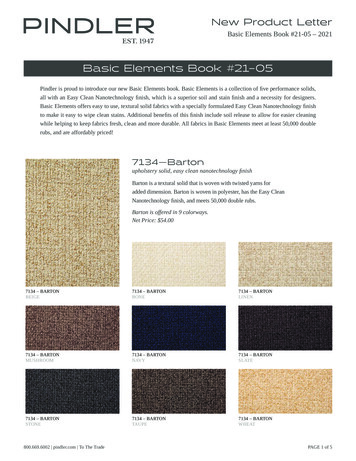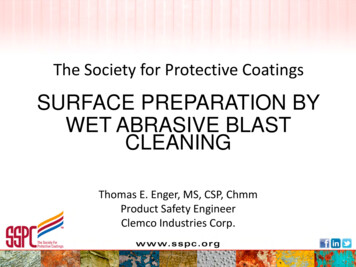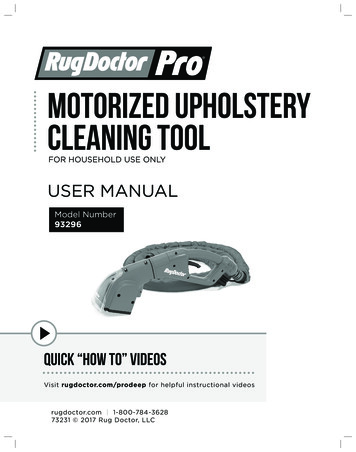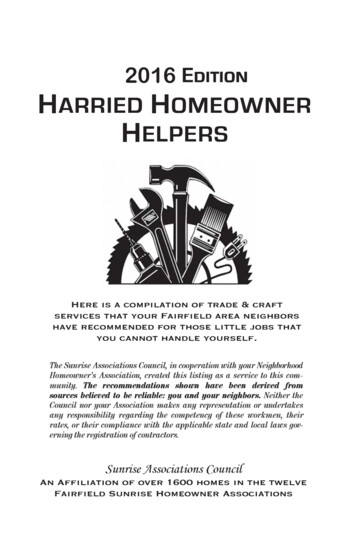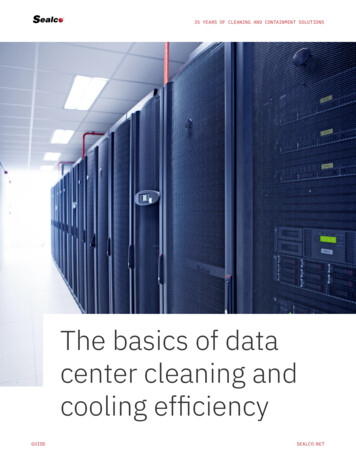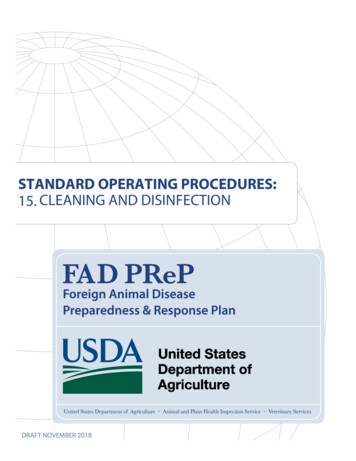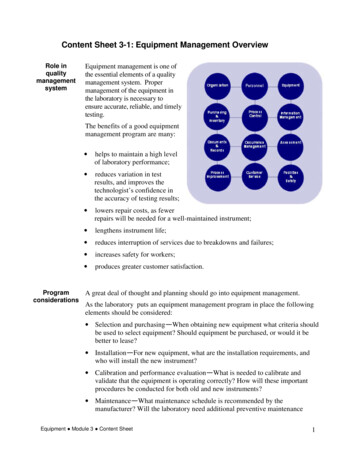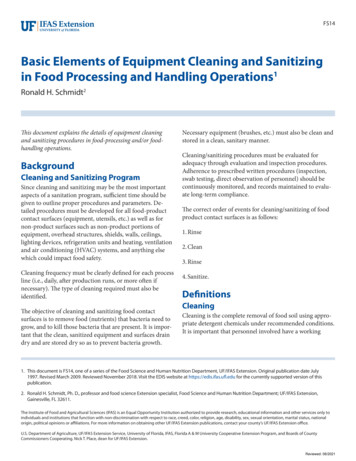
Transcription
FS14Basic Elements of Equipment Cleaning and Sanitizingin Food Processing and Handling Operations1Ronald H. Schmidt2This document explains the details of equipment cleaningand sanitizing procedures in food-processing and/or foodhandling operations.BackgroundCleaning and Sanitizing ProgramSince cleaning and sanitizing may be the most importantaspects of a sanitation program, sufficient time should begiven to outline proper procedures and parameters. Detailed procedures must be developed for all food-productcontact surfaces (equipment, utensils, etc.) as well as fornon-product surfaces such as non-product portions ofequipment, overhead structures, shields, walls, ceilings,lighting devices, refrigeration units and heating, ventilationand air conditioning (HVAC) systems, and anything elsewhich could impact food safety.Cleaning frequency must be clearly defined for each processline (i.e., daily, after production runs, or more often ifnecessary). The type of cleaning required must also beidentified.The objective of cleaning and sanitizing food contactsurfaces is to remove food (nutrients) that bacteria need togrow, and to kill those bacteria that are present. It is important that the clean, sanitized equipment and surfaces draindry and are stored dry so as to prevent bacteria growth.Necessary equipment (brushes, etc.) must also be clean andstored in a clean, sanitary manner.Cleaning/sanitizing procedures must be evaluated foradequacy through evaluation and inspection procedures.Adherence to prescribed written procedures (inspection,swab testing, direct observation of personnel) should becontinuously monitored, and records maintained to evaluate long-term compliance.The correct order of events for cleaning/sanitizing of foodproduct contact surfaces is as follows:1. Rinse2. Clean3. Rinse4. Sanitize.DefinitionsCleaningCleaning is the complete removal of food soil using appropriate detergent chemicals under recommended conditions.It is important that personnel involved have a working1. This document is FS14, one of a series of the Food Science and Human Nutrition Department, UF/IFAS Extension. Original publication date July1997. Revised March 2009. Reviewed November 2018. Visit the EDIS website at https://edis.ifas.ufl.edu for the currently supported version of thispublication.2. Ronald H. Schmidt, Ph. D., professor and food science Extension specialist, Food Science and Human Nutrition Department; UF/IFAS Extension,Gainesville, FL 32611.The Institute of Food and Agricultural Sciences (IFAS) is an Equal Opportunity Institution authorized to provide research, educational information and other services only toindividuals and institutions that function with non-discrimination with respect to race, creed, color, religion, age, disability, sex, sexual orientation, marital status, nationalorigin, political opinions or affiliations. For more information on obtaining other UF/IFAS Extension publications, contact your county’s UF/IFAS Extension office.U.S. Department of Agriculture, UF/IFAS Extension Service, University of Florida, IFAS, Florida A & M University Cooperative Extension Program, and Boards of CountyCommissioners Cooperating. Nick T. Place, dean for UF/IFAS Extension.Reviewed: 08/2021
understanding of the nature of the different types of foodsoil and the chemistry of its removal.Cleaning MethodsEquipment can be categorized with regard to cleaningmethod as follows: Mechanical Cleaning. Often referred to as clean-in-place(CIP). Requires no disassembly or partial disassembly. Clean-out-of-Place (COP). Can be partially disassembledand cleaned in specialized COP pressure tanks. Manual Cleaning. Requires total disassembly for cleaningand inspection.SanitizationIt is important to differentiate and define certainterminology: Sterilize refers to the statistical destruction and removalof all living organisms. Disinfect refers to inanimate objects and the destructionof all vegetative cells (not spores). Sanitize refers to the reduction of microorganisms tolevels considered safe from a public health viewpoint.Appropriate and approved sanitization procedures areprocesses, and, thus, the duration or time as well as thechemical conditions must be described. The officialdefinition (Association of Official Analytical Chemists) ofsanitizing for food product contact surfaces is a processwhich reduces the contamination level by 99.999% (5 logs)in 30 sec.The official definition for non-product contact surfacesrequires a contamination reduction of 99.9% (3 logs). Thestandard test organisms used are Staphylococcus aureus andEscherichia coli.General types of sanitization include the following: Thermal Sanitization involves the use of hot water orsteam for a specified temperature and contact time. Chemical Sanitization involves the use of an approvedchemical sanitizer at a specified concentration andcontact time.Water Chemistry and QualityWater comprises approximately 95%–99% of cleaning andsanitizing solutions. Water functions to do the following: carry the detergent or the sanitizer to the surface carry soils or contamination from the surface.The impurities in water can drastically alter the effectiveness of a detergent or a sanitizer. Water hardness is themost important chemical property with a direct effect oncleaning and sanitizing efficiency. (Other impurities canaffect the food contact surface or may affect the soil depositproperties or film formation.)Water pH ranges generally from pH 5 to 8.5. This range isof no serious consequence to most detergents and sanitizers. However, highly alkaline or highly acidic water mayrequire additional buffering agents.Water can also contain significant numbers of microorganisms. Water used for cleaning and sanitizing must bepotable and pathogen-free. Treatments and sanitizationof water may be required prior to use in cleaning regimes.Water impurities that affect cleaning functions are presented in Table 1.CleaningPROPERTIES OF FOOD SOILSFood soil is generally defined as unwanted matter on foodcontact surfaces. Soil is visible or invisible. The primarysource of soil is from the food product being handled.However, minerals from water residue and residues fromcleaning compounds contribute to films left on surfaces.Microbiological biofilms also contribute to the soil buildupon surfaces.Since soils vary widely in composition, no one detergent iscapable of removing all types. Many complex films containcombinations of food components, surface oil or dust,insoluble cleaner components, and insoluble hard-watersalts. These films vary in their solubility properties depending upon such factors as heat effect, age, dryness, time, etc.It is essential that personnel involved have an understanding of the nature of the soil to be removed before selectinga detergent or cleaning regime. The rule of thumb is thatacid cleaners dissolve alkaline soils (minerals) and alkalinecleaners dissolve acid soils and food wastes. Improper useof detergents can actually “set” soils, making them more difficult to remove (e.g., acid cleaners can precipitate protein).Many films and biofilms require more sophisticatedBasic Elements of Equipment Cleaning and Sanitizing in Food Processing and Handling Operations2
cleaners that are amended with oxidizing agents (such aschlorinated detergents) for removal.Soils may be classified as the following: soluble in water (sugars, some starches, most salts); soluble in acid (limestone and most mineral deposits); soluble in alkali (protein, fat emulsions); soluble in water, alkali, or acid.The physical condition of the soil deposits also affects itssolubility. Freshly precipitated soil in a cool or cold solutionis usually more easily dissolved than an old, dried, orbaked-on deposit, or a complex film. Food soils are complex in that they contain mixtures of several components.A general soil classification and removal characteristics arepresented in Table 2.Fat-Based Soilsmagnesium are involved in some of the most difficultmineral films. Under conditions involving heat andalkaline pH, calcium and magnesium can combine withbicarbonates to form highly insoluble complexes. Otherdifficult deposits contain iron or manganese. Salt filmscan also cause corrosion of some surfaces. Difficult saltfilms require an acid cleaner (especially organic acids thatform complexes with these salts) for removal. Sequesteringagents such as phosphates or chelating agents are often usedin detergents for salt film removal.Microbiological FilmsUnder certain conditions, microorgranisms (bacteria,yeasts, and molds) can form invisible films (biofilms) onsurfaces. Biofilms can be difficult to remove and usuallyrequire cleaners as well as sanitizers with strong oxidizingproperties.Lubricating Greases and OilsFat usually is present as an emulsion and can generally berinsed away with hot water above the melting point. Moredifficult fat and oil residues can be removed with alkalinedetergents, which have good emulsifying or saponifyingingredients.These deposits (insoluble in water, alkali, or acid) can oftenbe melted with hot water or steam, but often leave a residue.Surfactants can be used to emulsify the residue to make itsuspendable in water and flushable.Protein-Based SoilsInert soils such as sand, clay, or fine metal can be removedby surfactant-based detergents. Charred or carbonizedmaterial may require organic solvents.In the food industry, proteins are by far the most difficultsoils to remove. In fact, casein (a major milk protein) isused for its adhesive properties in many glues and paints.Food proteins range from more simple proteins, whichare easy to remove, to more complex proteins, which arevery difficult to remove. Heat-denatured proteins can beextremely difficult.Generally, a highly alkaline detergent with peptizing ordissolving properties is required to remove protein soils.Wetting agents can also be used to increase the wettabilityand suspendability of proteins. Protein films requirealkaline cleaners that have hypochlorite in addition towetting agents.Carbohydrate-Based SoilsSimple sugars are readily soluble in warm water and arequite easily removed. Starch residues, individually, are alsoeasily removed with mild detergents. Starches associatedwith proteins or fat scan usually be easily removed byhighly alkaline detergents.Mineral Salt-Based SoilsMineral salts can be either relatively easy to remove orbe highly troublesome deposits or films. Calcium andOther Insoluble SoilsQUANTITY OF SOILIt is important to rinse food-contact surfaces prior tocleaning to remove most of the soluble soil. Heavy depositsrequire more detergent to remove. Improper cleaning canactually contribute to build-up of soil.THE SURFACE CHARACTERISTICSThe cleanability of the surface is a primary considerationin evaluating cleaning effectiveness. Included in surfacecharacteristics are the following:Surface CompositionStainless steel is the preferred surface for food equipmentand is specified in many industry and regulatory designand construction standards. For example, 3-A SanitaryStandards (equipment standards used for milk and milkproducts applications) specify 300 series stainless steel orequivalent. Other grades of stainless steel may be appropriatefor specific applications (i.e., 400 series) such as handling ofhigh fat products, meats, etc. For highly acidic, high salt, orother highly corrosive products, more corrosion resistantmaterials (i.e., titanium) is often recommended.Basic Elements of Equipment Cleaning and Sanitizing in Food Processing and Handling Operations3
Other “soft” metals (aluminum, brass, copper, or mildsteel), or nonmetallic surfaces (plastics or rubber) are alsoused on food contact surfaces. Surfaces of soft metals andnonmetallic materials are generally less corrosion-resistantand care should be exercised in their cleaning.Aluminum is readily attacked by acids as well as highlyalkaline cleaners, which can render the surface noncleanable. Plastics are subject to stress cracking and clouding from prolonged exposure to corrosive food materials orcleaning agents.Hard wood (maple or equivalent) or sealed wood surfacesshould be used only in limited applications such as cuttingboards or cutting tables, provided the surface is maintainedin good repair. Avoid using porous wood surfaces.Surface FinishEquipment design and construction standards also specifyfinish and smoothness requirements. 3-A standards specifya finish at least as smooth as a No. 4 ground finish for mostapplications. With high-fat products, a less smooth surfaceis used to allow product release from the surface.Surface ConditionMisuse or mishandling can result in pitted, cracked,corroded, or roughened surfaces. Such surfaces are moredifficult to clean or sanitize, and may no longer be cleanable. Thus, care should be exercised in using corrosivechemicals or corrosive food products.ENVIRONMENTAL CONSIDERATIONSDetergents can be significant contributors to the wastedischarge (effluent). Of primary concern is pH. Manypublicly owned treatment works limit effluent pH to therange of 5 to 8.5. So it is recommended that in applicationswhere highly alkaline cleaners are used, that the effluent bemixed with rinse water (or some other method be used)to reduce the pH. Recycling of caustic soda cleaners is alsobecoming a common practice in larger operations. Otherconcerns are phosphates, which are not tolerated in someregions of the U.S., and the overall soil load in the wastestream that contributes to the chemical oxygen demand(COD) and biological oxygen demand (BOD).CHEMISTRY OF DETERGENTSDetergents and cleaning compounds are usually composedof mixtures of ingredients that interact with soils in severalways: Physically active ingredients alter physical characteristicssuch as solubility or colloidal stability. Chemically active ingredients modify soil components tomake them more soluble and, thus, easier to remove.In some detergents, specific enzymes are added to catalytically react with and degrade specific food soil components.Physically Active IngredientsThe primary physically-active ingredients are the surfaceactive compounds termed surfactants. These organicmolecules have general structural characteristic where aportion of the structure is hydrophilic (water-loving) anda portion is hydrophobic (not reactive with water). Suchmolecules function in detergents by promoting the physicalcleaning actions through emulsification, penetration,spreading, foaming, and wetting.The classes of surfactants are as follows: Ionic surfactants that are negatively charged in watersolution are termed anionic surfactants. Conversely,positively charged ionic surfactants are termed cationicsurfactants. If the charge of the water soluble portiondepends upon the pH of the solution, it is termed anamphoteric surfactant. These surfactants behave ascationic surfactants under acid conditions, and as anionicsurfactants under alkaline conditions. Ionic surfactantsare generally characterized by their high foaming ability. Nonionic surfactants, which do not dissociate whendissolved in water, have the broadest range of propertiesdepending upon the ratio of hydrophilic/hydrophobicbalance. This balance are also affected by temperature. Forexample, the foaming properties of nonionic detergents isaffected by temperature of solution. As temperature increases, the hydrophobic character and solubility decrease.At the cloud point (minimum solubility), these surfactantsgenerally act as defoamers, while below the cloud point theyare varied in their foaming properties.It is a common practice to blend surfactant ingredients tooptimize their properties. However, because of precipitation problems, cationic and anionic surfactants cannot beblended.Chemically Active IngredientsAlkaline BuildersHighly Alkaline Detergents (or heavy-duty detergents) usecaustic soda (sodium hydroxide) or caustic potash (potassium hydroxide). An important property of these highlyalkaline detergents is that they saponify fats: forming soap.Basic Elements of Equipment Cleaning and Sanitizing in Food Processing and Handling Operations4
These cleaners are used in many CIP systems or bottlewashing applications.Moderately Alkaline Detergents include sodium, potassium, or ammonium salts of phosphates, silicates, orcarbonates. Tri-sodium phosphate (TSP) is one of the oldestand most effective. Silicates are most often used as a corrosion inhibitor. Because of interaction with calcium andmagnesium and film formation, carbonate-based detergentsare of only limited use in food processing cleaning regimes.Acid BuildersAcid Detergents include organic and inorganic acids. Themost common inorganic acids used include phosphoric,nitric, sulfamic, sodium acid sulfate, and hydrochloric.Organic acids, such as hydroxyacetic, citric, and gluconic,are also in use. Acid detergents are often used in a two-stepsequential cleaning regime with alkaline detergents. Aciddetergents are also used for the prevention or removal ofstone films (mineral stone, beer stone, or milk stone).Water ConditionersWater conditioners are used to prevent the build-up of various mineral deposits (water hardness, etc.). These chemicalsare usually sequestering agents or chelating agents.Sequestering agents form soluble complexes with calciumand magnesium. Examples are sodium tripolyphosphate,tetra-potassium pyrophosphate, organo-phosphates, andpolyelectrolytes. Chelating agents include sodium gluconateand ethylene diamine tetracetic acid (EDTA).Oxidizing AgentsOxidizing agents used in detergent application arehypochlorite (also a sanitizer) and—to a lesser extent—perborate. Chlorinated detergents are most often used to cleanprotein residues.Enzyme IngredientsEnzyme-based detergents, which are amended with enzymes such as amylases and other carbohydrate-degradingenzymes, proteases, and lipases, are finding acceptance inspecialized food industry applications.The primary advantages of enzyme detergents are thatthey are more environmentally friendly and often requireless energy input (less hot water in cleaning). Uses of mostenzyme cleaners are usually limited to unheated surfaces(e.g., cold-milk surfaces). However, new generation enzymecleaners (currently under evaluation) are expected to havebroader application.FillersFillers add bulk or mass, or dilute dangerous detergentformulations that are difficult to handle. Strong alkalis areoften diluted with fillers for ease and safety of handling.Water is used in liquid formulations as a filler. Sodiumchloride or sodium sulfate are often fillers in powdereddetergent formuations.Miscellaneous IngredientsAdditional ingredients added to detergents may includecorrosion inhibitors, glycol ethers, and butylcellosolve(improve oil, grease, and carbon removal).SanitizingTHERMAL SANITIZINGAs with any heat treatment, the effectiveness of thermalsanitizing is dependant upon a number of factors includinginitial contamination load, humidity, pH, temperature, andtime.SteamThe use of steam as a sanitizing process has limited application. It is generally expensive compared to alternatives, andit is difficult to regulate and monitor contact temperatureand time. Further, the byproducts of steam condensationcan complicate cleaning operations.Hot WaterHot-water sanitizing—through immersion (small parts,knives, etc.), spray (dishwashers), or circulating systems—iscommonly used. The time required is determined by thetemperature of the water. Typical regulatory requirements(Food Code 1995) for use of hot water in dishwashing andutensil sanitizing applications specify immersion for atleast 30 sec. at 77 C (170 F) for manual operations; anda final rinse temperature of 74 C (165 F) in single tank,single temperature machines and 82 C (180 F) for othermachines.Many state regulations require a utensil surface temperatureof 71 C (160 F), as measured by an irreversibly registeringtemperature indicator in warewashing machines. Recommendations and requirements for hot-water sanitizing infood processing may vary. The Grade A Pasteurized MilkOrdinance specifies a minimum of 77 C (170 F) for 5 min.Other recommendations for processing operations are 85 C(185 F) for 15 min., or 80 C (176 F) for 20 min.The primary advantages of hot-water sanitization arerelatively inexpensive, easy to apply, and readily available,generally effective over a broad range of microorganisms,Basic Elements of Equipment Cleaning and Sanitizing in Food Processing and Handling Operations5
relatively non-corrosive, and penetrates into cracks andcrevices. Hot-water sanitization is a slow process thatrequires come-up and cool-down time; can have highenergy costs; and has certain safety concerns for employees.The process also has the disadvantages of forming orcontributing to film formations and shortening the life ofcertain equipment or parts thereof (gaskets, etc.).CHEMICAL SANITIZINGThe ideal chemical sanitizer should: be approved for food contact surface application. have a wide range or scope of activity. destroy microorganisms rapidly. be stable under all types of conditions. be tolerant of a broad range of environmental conditions. be readily solubilized and possess some detergency. be low in toxicity and corrosivity. be inexpensive.No available sanitizer meets all of the above criteria.Therefore, it is important to evaluate the properties,advantages, and disadvantages of available sanitizer for eachspecific application.Regulatory ConsiderationsThe regulatory concerns involved with chemical sanitizersare antimicrobial activity or efficacy, safety of residueson food contact surfaces, and environmental safety. It isimportant to follow regulations that apply for each chemicalusage situation. The registration of chemical sanitizers andantimicrobial agents for use on food and food productcontact surfaces and on nonproduct contact surfaces isthrough the U.S. Environmental Protection Agency (EPA).(Prior to approval and registration, the EPA reviews efficacyand safety data, and product labeling information.)The U.S. Food and Drug Administration (FDA) is primarilyinvolved in evaluating residues form sanitizer use thatmay enter the food supply. Thus, any antimicrobial agentand its maximum usage level for direct use on food oron food product contact surfaces must be approved bythe FDA. Approved no-rinse food contact sanitizers andnonproduct contact sanitzers, their formulations and usagelevels are listed in the Code of Federal Regulations (21 CFR178.1010). The U.S. Department of Agriculture (USDA)also maintains lists of antimicrobial compounds (i.e., USDAList of Proprietary Substances and Non Food Product ContactCompounds), which are primarily used in the regulation ofmeats, poultry, and related products by USDA’s Food Safetyand Inspection Service (FSIS).Factors Affecting Sanitizer EffectivenessPhysical FactorsSurface Characteristics. Prior to the sanitization process,all surfaces must be clean and thoroughly rinsed to removeany detergent residue. An unclean surface cannot besanitized. Since the effectiveness of sanitization requiresdirect contact with the microorganisms, the surfaceshould be free of cracks, pits, or crevices which can harbormicroorganisms. Surfaces which contain biofilms cannot beeffectively sanitized.Exposure Time. Generally, the longer time a sanitizerchemical is in contact with the equipment surface, themore effective the sanitization effect; intimate contact is asimportant as prolonged contact.Temperature. Temperature is also positively related tomicrobial kill by a chemical sanitizer. Avoid high temperatures (above 55 C [131 F]) because of the corrosive natureof most chemical sanitizers.Concentration. Generally, the activity of a sanitizerincreases with increased concentration. However, a levelingoff occurs at high concentrations. A common misconception regarding chemicals is that “if a little is good, more isbetter”. Using sanitizer concentrations above recommendations does not sanitizer better and, in fact, can be corrosiveto equipment and in the long run lead to less cleanability.Follow manufacturer’s label instructions.Soil. The presence of organic matter dramatically reducesthe activity of sanitizers and may, in fact, totally inactivatethem. The adage is “you cannot sanitize an unclean surface”.Chemical FactorspH. Sanitizers are dramatically affected by the pH of thesolution. Many chlorine sanitizers, for example, are almostineffective at pH values above 7.5.Water properties. Certain sanitizers are markedly affectedby impurities in the water.Inactivators. Organic and/or inorganic inactivatorsmay react chemically with sanitizers giving rise to nongermicidal products. Some of these inactivators are presentin detergent residue. Thus, it is important that surfaces berinsed prior to sanitization.Basic Elements of Equipment Cleaning and Sanitizing in Food Processing and Handling Operations6
Biological FactorsThe microbiological load can affect sanitizer activity. Also,the type of microorganism present is important. Sporesare more resistant than vegetative cells. Certain sanitizersare more active against gram positive than gram negativemicroorganisms, and vice versa. Sanitizers also vary in theireffectiveness against yeasts, molds, fungi, and viruses.Specific Types of Chemical SanitizersThe chemicals described here are those approved byFDA for use as no-rinse, food-contact surface sanitizers.In food-handling operations, these are used as rinses,sprayed onto surfaces, or circulated through equipmentin CIP operations. In certain applications the chemicalsare foamed on a surface or fogged into the air to reduceairborne contamination.Chlorine-Based SanitizersChlorine Compounds. Chlorine, in its various forms, isthe most commonly used sanitizer in food processing andhandling applications. Commonly used chlorine compounds include liquid chlorine, hypochlorites, inorganicchloramines, and organic chloramines. Chlorine-basedsanitizers form hypochlorous acid (HOCl, the most activeform) in solution. Available chlorine (the amount of HOClpresent) is a function of pH. At pH 5, nearly all is in theform of HOCl. At pH 7.0, approximately 75% is HOCl.The maximum allowable level for no-rinse applications is200ppm available chlorine, but recommended usage levelsvary. For hypochlorites, an exposure time of 1 min at aminimum concentration of 50ppm and a temperature of24 C (75 F) is recommended. For each 10 C (18 F) drop intemperature, a doubling of exposure time is recommended.For chloramines, 200ppm for 1 min is recommended.Chlorine compounds are broad spectrum germicides thatact on microbial membranes, inhibit cellular enzymesinvolved in glucose metabolism, have a lethal effect onDNA, and oxidize cellular protein. Chlorine has activityat low temperature, is relatively cheap, and leaves minimalresidue or film on surfaces.The activity of chlorine is dramatically affected by suchfactors as pH, temperature, and organic load. However,chlorine is less affected by water hardness when comparedto other sanitizers (especially the quaternary ammoniumcompounds).The major disadvantage to chlorine compound is corrosiveness to many metal surfaces (especially at higher temperatures). Health and safety concerns can occur because ofskin irritation and mucous membrane damage in confinedareas. At low pH (below 4.0), deadly Cl2 (mustard gas) canform. In recent years, concerns have also been raised aboutthe use of chlorine as a drinking water disinfectant and asan antimicrobial with direct food contact (meat, poultryand shellfish). This concern is based upon the involvementof chlorine in the formation of potentially carcinogenictrihalomethanes (THMs) under appropriate conditions.While chlorine’s benefits as a sanitizer far outweigh theserisks, it is under scrutiny.Chlorine dioxide. Chlorine dioxide (ClO2) is currentlybeing considered as a replacement for chlorine, since itappears to be more environmentally friendly. StabilizedClO2 has FDA approval for most applications in sanitizingequipment or for use as a foam for environmental and nonfood contact surfaces. Approval has also been granted foruse in flume waters in fruits and vegetable operations andin poultry process waters. ClO2 has 2.5 times the oxidizingpower of chlorine and, thus, less chemical is required.Typical use concentrations range from 1 to 10ppm.CLO2’s primary disadvantages are worker safety andtoxicity. Its highly concentrated gases can be explosiveand exposure risks to workers are higher than that forchlorine. Its rapid decomposition in the presence of lightor at temperatures greater than 50 C (122 F) makes on-sitegeneration a recommended practice.IodineUse of iodine as an antimicrobial agents dates back to the1800s. This sanitizer exists in many forms and usually existswith a surfactant as a carrier. These mixtures are termediodophors. The most active agent is the dissociated freeiodine (also less stable). This form is most prevalent atlow pH. The amount of dissociation from the surfactant isdependent upon the type of surfactant. Iodine solubility isvery limited in water. Generally recommended usage foriodophors is 12.5 to 25ppm for 1 min.It is generally thought that the bactericidal activity of iodineis through direct halogenation of proteins. More recenttheories have centered upon cell wall damage and destruction of microbial enzyme activity.Iodophors, like chlorine compounds, have a very broadspectrum: being active against bacteria, viruses, yeasts,molds, fungi, and protozoans. Iodine is highly temperaturedependent and vaporizes at 120 F. Thus, it is limited tolower temperature applications. The degree to whichiodophors are affected by environmental factors is highlydependant upon properties of the surfactant used in theformulation. Iodophors are generally less affected byBasic Elements of Equipment Cleaning and Sanitizing in Food Processing and Handling Operations7
organic matter and water hardness than chlorine. However,loss of activi
Clean-out-of-Place (COP). Can be partially disassembled and cleaned in specialized COP pressure tanks. Manual Cleaning. Requires total disassembly for cleaning and inspection. Sanitization It is important to differentiate and define certain terminology: Sterilize refers to the sta

